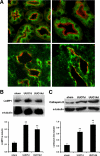Autophagy is a component of epithelial cell fate in obstructive uropathy
- PMID: 20150430
- PMCID: PMC2843468
- DOI: 10.2353/ajpath.2010.090345
Autophagy is a component of epithelial cell fate in obstructive uropathy
Abstract
Epithelial cell fate and nephron loss in obstructive uropathy are not fully understood. We produced transgenic mice in which epithelial cells in the nephrons and collecting ducts were labeled with enhanced yellow fluorescent protein, and tracked the fate of these cells following unilateral ureteral obstruction (UUO). UUO led to a decrease in the number of enhanced yellow fluorescent protein-expressing cells and down-regulation of epithelial markers, E-cadherin, and hepatocyte nuclear factor-1beta. Following UUO, enhanced yellow fluorescent protein-positive cells were confined within the tubular basement membrane, were not found in the renal interstitium, and did not express alpha-smooth muscle actin or S100A4, markers of myofibroblasts and fibroblasts. Moreover, when proximal tubules were labeled with dextran before UUO, dextran-retaining cells did not migrate into the interstitium or express alpha-smooth muscle actin. These results indicate that UUO leads to tubular epithelial loss but does not cause epithelial-to-mesenchymal transition that has been shown by others to be responsible for nephron loss and interstitial fibrosis. For the first time, we found evidence of enhanced autophagy in obstructed tubules, including accumulation of autophagosomes, increased expression of Beclin 1, and increased conversion of microtubular-associated protein 1 light chain 3-I to -II. Increased autophagy may represent a mechanism of tubular survival or may contribute to excessive cell death and tubular atrophy after obstructive injury.
Figures








Similar articles
-
Fate tracing reveals the pericyte and not epithelial origin of myofibroblasts in kidney fibrosis.Am J Pathol. 2010 Jan;176(1):85-97. doi: 10.2353/ajpath.2010.090517. Epub 2009 Dec 11. Am J Pathol. 2010. PMID: 20008127 Free PMC article.
-
Autophagy and apoptosis in tubular cells following unilateral ureteral obstruction are associated with mitochondrial oxidative stress.Int J Mol Med. 2013 Mar;31(3):628-36. doi: 10.3892/ijmm.2013.1232. Epub 2013 Jan 8. Int J Mol Med. 2013. PMID: 23314838
-
Persistent activation of autophagy in kidney tubular cells promotes renal interstitial fibrosis during unilateral ureteral obstruction.Autophagy. 2016 Jun 2;12(6):976-98. doi: 10.1080/15548627.2016.1166317. Epub 2016 Apr 28. Autophagy. 2016. PMID: 27123926 Free PMC article.
-
Tubular epithelial-myofibroblast transdifferentiation mechanisms in proximal tubule cells.Curr Opin Nephrol Hypertens. 2003 Jan;12(1):25-9. doi: 10.1097/00041552-200301000-00005. Curr Opin Nephrol Hypertens. 2003. PMID: 12496662 Review.
-
Fibroblast activation and myofibroblast generation in obstructive nephropathy.Nat Rev Nephrol. 2009 Jun;5(6):319-28. doi: 10.1038/nrneph.2009.74. Nat Rev Nephrol. 2009. PMID: 19474827 Review.
Cited by
-
Loss of glutathione S-transferase A4 accelerates obstruction-induced tubule damage and renal fibrosis.J Pathol. 2012 Dec;228(4):448-58. doi: 10.1002/path.4067. Epub 2012 Jul 26. J Pathol. 2012. PMID: 22711583 Free PMC article.
-
Fight-or-flight: murine unilateral ureteral obstruction causes extensive proximal tubular degeneration, collecting duct dilatation, and minimal fibrosis.Am J Physiol Renal Physiol. 2012 Jul 1;303(1):F120-9. doi: 10.1152/ajprenal.00110.2012. Epub 2012 Apr 25. Am J Physiol Renal Physiol. 2012. PMID: 22535799 Free PMC article.
-
Autophagy in Cisplatin Nephrotoxicity during Cancer Therapy.Cancers (Basel). 2021 Nov 10;13(22):5618. doi: 10.3390/cancers13225618. Cancers (Basel). 2021. PMID: 34830772 Free PMC article. Review.
-
Cathepsin S regulates renal fibrosis in mouse models of mild and severe hydronephrosis.Mol Med Rep. 2019 Jul;20(1):141-150. doi: 10.3892/mmr.2019.10230. Epub 2019 May 9. Mol Med Rep. 2019. PMID: 31115520 Free PMC article.
-
Microvascular targets for anti-fibrotic therapeutics.Yale J Biol Med. 2013 Dec 13;86(4):537-54. Yale J Biol Med. 2013. PMID: 24348218 Free PMC article. Review.
References
-
- Smith JM, Stablein DM, Munoz R, Hebert D, McDonald RA. Contributions of the transplant registry: the 2006 annual report of the North American Pediatric Renal Trials and Collaborative Studies (NAPRTCS). Pediatr Transplant. 2007;11:366–373. - PubMed
-
- Chevalier RL. Pathogenesis of renal injury in obstructive uropathy. Curr Opin Pediatr. 2006;18:153–160. - PubMed
-
- Chevalier RL, Peters CA. Congenital urinary tract obstruction: proceedings of the State-Of-The-Art Strategic Planning Workshop-National Institutes of Health. Bethesda, Maryland, 11–12 March 2002. Pediatr Nephrol. 2003;18:576–606. - PubMed
-
- Woolf AS, Price KL, Scambler PJ, Winyard PJ. Evolving concepts in human renal dysplasia. J Am Soc Nephrol. 2004;15:998–1007. - PubMed
-
- Potter E. Normal and abnormal development of the kidney. Chicago: Year Book Medical Publishers,; 1972:pp. 1–305.
Publication types
MeSH terms
Substances
Grants and funding
LinkOut - more resources
Full Text Sources
Other Literature Sources
Molecular Biology Databases
Research Materials

